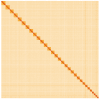The genome sequence of the Green-brindled Crescent, Allophyes oxyacanthae (Linnaeus, 1758)
- PMID: 39148947
- PMCID: PMC11325130
- DOI: 10.12688/wellcomeopenres.18935.1
The genome sequence of the Green-brindled Crescent, Allophyes oxyacanthae (Linnaeus, 1758)
Abstract
We present a genome assembly from an individual male Allophyes oxyacanthae (the Green-brindled Crescent; Arthropoda; Insecta; Lepidoptera; Noctuidae). The genome sequence is 458 megabases in span. The whole assembly is scaffolded into 31 chromosomal pseudomolecules, including the assembled Z sex chromosome. The mitochondrial genome has also been assembled and is 15.3 kilobases in length. Gene annotation of this assembly on Ensembl has identified 17,301 protein coding genes.
Keywords: Allophyes oxyacanthae; Green-brindled Crescent; Lepidoptera; chromosomal; genome sequence.
Copyright: © 2023 Boyes D et al.
Conflict of interest statement
No competing interests were disclosed.
Figures





Similar articles
-
The genome sequence of the Olive Crescent, Trisateles emortualis (Denis & Schiffermüller, 1775).Wellcome Open Res. 2024 Apr 8;9:178. doi: 10.12688/wellcomeopenres.20836.1. eCollection 2024. Wellcome Open Res. 2024. PMID: 40012989 Free PMC article.
-
The genome sequence of the Burnished Brass, Diachrysia chrysitis (Linnaeus, 1758).Wellcome Open Res. 2023 Feb 15;8:82. doi: 10.12688/wellcomeopenres.18990.1. eCollection 2023. Wellcome Open Res. 2023. PMID: 37484482 Free PMC article.
-
The genome sequence of the Crescent Groundling, Teleiodes luculella (Hübner, 1813).Wellcome Open Res. 2024 Mar 11;9:143. doi: 10.12688/wellcomeopenres.21090.1. eCollection 2024. Wellcome Open Res. 2024. PMID: 39139615 Free PMC article.
-
The genome sequence of the Dark Spectacle, Abrostola triplasia (Linnaeus, 1758).Wellcome Open Res. 2023 Jun 27;8:278. doi: 10.12688/wellcomeopenres.19624.1. eCollection 2023. Wellcome Open Res. 2023. PMID: 37766851 Free PMC article.
-
The genome sequence of the Hebrew Character, Orthosia gothica (Linnaeus, 1758).Wellcome Open Res. 2024 Feb 19;9:90. doi: 10.12688/wellcomeopenres.20904.1. eCollection 2024. Wellcome Open Res. 2024. PMID: 39429633 Free PMC article.
References
-
- Ford EB: Moths.London: New Naturalist, Collins.1967. Reference Source
LinkOut - more resources
Full Text Sources

